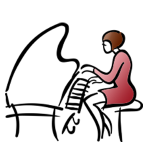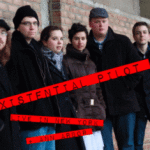Yikes! 11 days into 2008 and this is my first post of the year! (My previous post says January 1, but it was still New Year’s Eve where I am when I posted it. My time stamp comes from somewhere over the Atlantic ocean…)
The reason the only sound coming from this blog has been crickets (as opposed to cicadas) is that I’ve been working feverishly, day and night, to finish my Concerto for Theremin and Chamber Orchestra, which will be premiered in March by the San Diego Chamber Orchestra, with my good friend Scott Paulson playing the theremin solo. I finally reached the coveted double barline today!
There’s still plenty more to do — making the score look nice and preparing the parts for all the different instruments, for example. But those tasks are pretty straightforward, which is not to say easy… they’re mainly painstaking and time-consuming. But they don’t require inspiration, the cooperation of the muse, that certain je ne sais quoi that makes every creative project take approximately 3 times longer than you expect. If only it could be like building a brick wall — you just lay brick after brick, steadily and consistently, until you’re done. Nope, composition doesn’t work that way. The process goes in fits and starts. Some days I’ll worry over 10 seconds of music like a dog with a bone… other days I’ll write two minutes of music in an hour and then head for the beach! (Well, not in Michigan in January, but you get the picture.)
I’m not denying that there’s a discipline and routine to it — the bottom line is, you just have to sit down and get to work — but sometimes “work” looks like staring at a blank page trying to decide whether to tear it up, poke holes in it with your pencil, spill coffee on it… or write something, anything… and keep working it til it works. It’s a mysterious and beautiful process. It’s easy for me to say that now, because I’m not right in the thick of it… I’m done, woo hoo!
…unless the conductor hates it. In which case I’ll be back with some wicked conductor jokes. (You can take most any lawyer joke you know and substitute conductors… or violists… 😉 )
By the way, the software for music notation and audio editing uses every last drop of RAM and CPU power the computer can muster; I joked with a friend today that my compy was running on a hamster wheel. He sent me a link in response — some brilliant person has built a Hamster controlled MIDI sequencer. This is not a joke! You can hear the musical results, and they sound like quirky minimalism! Heh heh, I know that’s a terrible thing to say about minimalism — that’s another story for another day… 😉
If you enjoyed this post, would you consider…
Thanks — you make the world a better place! 🙂





Does this mean I should be planning a date to attend a concert? 😉
Congrats on the performance! SDCO was pretty good back in the day when I was down there about 20 years ago. David Amos was the conductor then. They premiered a Paul Creston string piece that was pretty interesting.
I know what you mean about copying and editing the parts for the performance. And then when the musicians and the conductor have scribbled all over the parts, you can take them back and see if there’s anything to put into the part and then the score…. Best of Luck
Good conductor joke:
Two first violinists [The concertmaster and the assistant cm] met the day after a performance that required an emergency substitute conductor to replace the regular conductor:
Assistant Cm – ” Hey, where the hell were you last night? WE had an emergency substitute conductor cuz old wiggle-stick took sick?”
Cm – ” I was called up to substitute for a sick conductor. I led the orchestra through an exhausting program in spite of their mediocrity.”
BTW- Violas are better than violins any day – they burn almost twice as long
I don’t do much writing anymore, but things have sure changed from the “early days.” I remember long hours preparing my final copy on velum with India ink. If I made a mistake, I had to make the decision to try to erase with a mechanical eraser or just start the page all over again. It was, however, beautiful artwork when it was done (the written page that is, not necessarily the music–but one could hope).
Once the velum masters were done, it was off to the blueprinters to get copies made. Hopefully, they adhered to my instructions to print “blackline,” but once in a while I receive a dozen copies in my “printing run” that would be all blueline. Dang, I hated when that happened. And this process was expensive, too. Maybe 10 or 12 bucks a copy, and this was back in the mid ’70’s!
Parts were another matter entirely. Either I could snip each line of a part out and paste them on a new sheet–which always looked messy–or I could start hand-writing the score all over again on velum, but this time one part at a time. What a process. It got to be that the mechanics took more time than the creative process. Oh for the days.
Anyway, I was at the top of my game creatively, technologically, and in about every other way about 1980. A lot has passed me by since (you should see my collection or vinyl that is gathering dust these days).
Well, congrats on again reaching the double bar. All composers are very happy each time they accomplish that feat.